
The Aga Khan Award for Architecture (AKAA) is an architectural prize established by Aga Khan IV in 1977. It aims to identify and reward architectural concepts that successfully address the needs and aspirations of Muslim societies in the fields of contemporary design, social housing, community development and improvement, restoration, reuse and area conservation, as well as landscape design and improvement of the environment.

Baitul Mukarram, also spelled as Baytul Mukarrom, is the National Mosque of Bangladesh. Located at the center of Dhaka, capital of Bangladesh, the mosque was completed in 1968. It has a capacity of 42,000+.
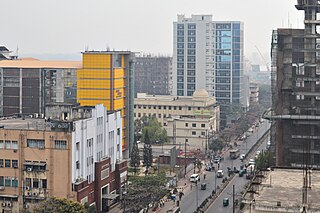
Chittagong District, renamed the Chattogram District, is a district located in the south-eastern region of Bangladesh. It is a part of the Chattogram Division. The port city of Chattogram, which is the second largest city in Bangladesh, is located within this district.

The architecture of Bengal, which comprises the modern country of Bangladesh and the Indian states of West Bengal, Tripura and Assam's Barak Valley, has a long and rich history, blending indigenous elements from the Indian subcontinent, with influences from different parts of the world. Bengali architecture includes ancient urban architecture, religious architecture, rural vernacular architecture, colonial townhouses and country houses and modern urban styles. The bungalow style is a notable architectural export of Bengal. The corner towers of Bengali religious buildings were replicated in medieval Southeast Asia. Bengali curved roofs, suitable for the very heavy rains, were adopted into a distinct local style of Indo-Islamic architecture, and used decoratively elsewhere in north India in Mughal architecture.
Hathazari is an upazila of Chattogram District in Chattogram Division, Bangladesh.
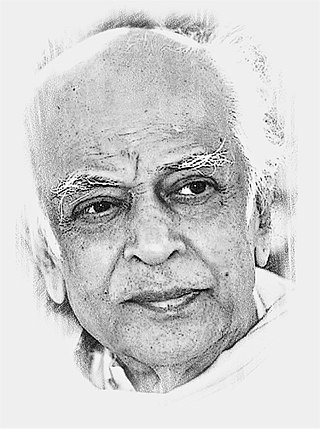
Muzharul Islam was a Bangladeshi architect, urban planner, educator and activist. He is considered as the Grand Master of regional modernism in South Asia. Islam is the pioneer of modern architecture in Bangladesh and the father of Bengali modernism. Islam's style and influence dominated the architectural scene in the country during the 1960s and 70s, along with major US architects he brought to work in Dhaka.

Tourism in Bangladesh includes tourism to World Heritage Sites, historical monuments, resorts, beaches, picnic spots, forests, tribal people, and wildlife of various species. Activities for tourists include angling, water skiing, river cruising, hiking, rowing, yachting, and sea bathing.
Friendship is a needs-driven non-governmental organisation that works in the Char islands and riverbanks of northern Bangladesh, the coastal belt in the south, and as of 2017, the Rohingya refugee camps in Ukhia, Cox's Bazar in the southeast. Established by Runa Khan in 2002, Friendship works to empower people through a sustainable, integrated development approach.

The Samdani Art Foundation is a private art foundation founded in 2011 in Dhaka, Bangladesh that aims to increase artistic engagement between the art and architecture of Bangladesh and the rest of the world. It is best known for producing the bi-annual Dhaka Art Summit, which is the highest daily visited contemporary art exhibition in the world, welcoming over 477,000 visitors in its fifth edition in February 2020. The foundation produces education programmes and exhibitions across the year in collaboration with Bangladeshi and international institutions, and is one of the most active art institutions in South Asia.
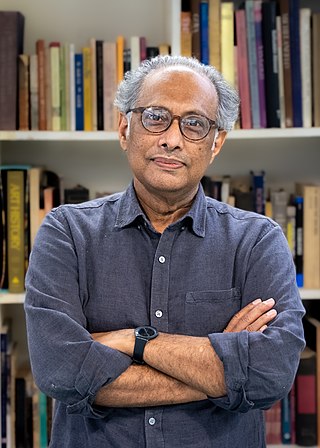
Kazi Khaleed Ashraf is a Bangladeshi architect, urbanist and architectural historian. Writing from the intersection of architecture, landscape and the city, Ashraf has authored books and essays on architecture in India and Bangladesh, the work of Louis Kahn, and the city of Dhaka. His various writings on the architecture of Bangladesh have provided a theoretical ground for understanding both the historical and contemporary forms of architecture, while his written and design work on Dhaka advances that city as a "theorem" for understanding urbanism in a deltaic geography. Ashraf and contributing team received the Pierre Vago Journalism Award from the International Committee of Architectural Critics for the Architectural Design publication Made in India. He has also co-authored a number of publications with the architect Saif Ul Haque. Ashraf has recently established an international publication series called Locations: Anthology of Architecture and Urbanism that will present works and features from around the globe.

Saif Ul Haque is an architect and educator based in Dhaka. He received Aga Khan Award for Architecture in 2017-2019 cycle.
Ehsan Khan is a Bangladeshi architect and activist.

Swadhinata Stambha or Independence Monument is a national monument in Bangladesh to commemorate the historical events that took place in the Suhrawardy Udyan, previously known as Ramna Race Course ground regarding the Liberation War of Bangladesh.

The Museum of Independence in Dhaka, Bangladesh depicts the struggle for independence of Bangladesh. It shows the history of the nation since Mughal tenure to independence in 1971. It is the first and only underground museum in the country. The museum is part of a 67-acre complex at Suhrawardy Udyan, the site from where Sheikh Mujibur Rahman gave his historic speech declaring the struggle for independence, and where the Pakistani forces surrendered after the War of Liberation. The museum was opened to public on March 25, 2015, the 45th Independence Day of Bangladesh.
Chandgaon Mosque is a mosque in Chittagong, Bangladesh, completed in 2007. Designed by Kashef Mahboob Chowdhury, it was shortlisted for the Aga Khan Award for Architecture in 2010.

Marina Tabassum is a Bangladeshi architect. She is the principal architect of Marina Tabassum Architects. In 2016, she won the Aga Khan Award for Architecture for the design of Bait-ur-Rouf Mosque in Dhaka, Bangladesh.
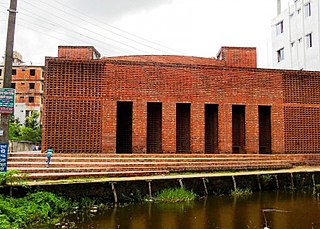
The Bait Ur Rouf Mosque is a distinctive urban mosque located in an economically-challenged area of Dhaka, Bangladesh. Designed by Bangladeshi architect Marina Tabassum and completed in 2012, it has been called a refuge of spirituality in urban Dhaka and received recognition for its beautiful use of natural light and for challenging the status quo of traditional mosque design. Instead of traditional symbolism such as domes and minarets, the mosque relies on open space and the rich interplay of light and shadow to create a prayer space that elevates the spirit.
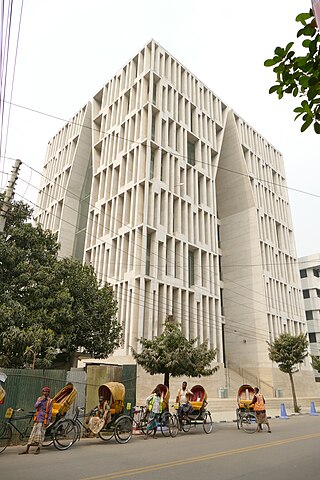
The Gulshan Society Mosque, also called Gulshan Society Jame Masjid, is a Mosque in Banani Model Town, a neighbourhood in Dhaka. It was planned by Kashef Chowdhury and completed in 2017.
















